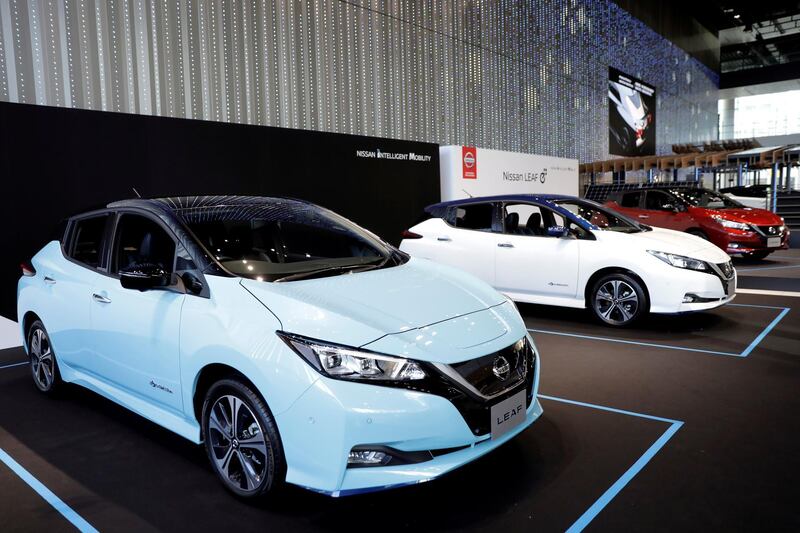Fuji Oozx is one of hundreds of automotive parts suppliers in Japan whose very existence is being threatened by the world’s shift toward electric vehicles.
For almost 70 years, the company has been making intake valves, an essential component of any petrol car that controls the flow of gas in and out of an engine’s cylinder. Typically made of copper, they are light and highly heat-resistant and use a decades-old technology that is not needed in any electric car.
“We have to start looking for a new business,” President Satoshi Tsujimoto, 63, said from his office adjacent to Fuji Oozx’s factory in Shizuoka prefecture, an elongated region that traces the coast of the Pacific Ocean. Fuji Oozx supplies car makers including Toyota Motor and Nissan Motor.
Valves for boat engines are one option but the Tokyo-listed company’s board is also looking farther afield, perhaps branching into medical devices. “We have no choice but to fight for survival. We’ll have to find an answer in the next decade,” Mr Tsujimoto said.
His predicament is one that other suppliers of traditional automotive parts around the world are confronting as the industry accelerates its shift away from the combustion engine. They either make the shift too, or find completely new avenues of business. The situation is particularly acute in Japan, where the government has pledged to go carbon neutral by 2050. A key part of that will be transitioning to cleaner cars, which currently only make up about 1 per cent of vehicles, compared with 30 per cent in parts of China, the global EV trailblazer.
Management consultancy Arthur D Little predicts that as many as 300,000 jobs may disappear in Japan if the automotive sector makes a full shift to EVs, equal to about 10 per cent of all jobs in the industry. In the US, it is estimated about 75,000 jobs could be lost if battery electric vehicles make up around 50 per cent of domestic auto sales by 2030.
“It’s the boiled frog phenomenon,” Arthur D Little consultant Kensuke Sobue said. Japan risks slowly but surely losing jobs as other countries, notably China, nurture the EV sector, creating employment opportunities.
Shizuoka is home to a many auto parts suppliers that count some of the industry’s biggest names as clients. It is one of Japan’s key centres for combustion-engine car-part manufacturers, accounting for more than half the prefecture’s supply chain in 2018, figures from the Shizuoka Economic Research Institute show.
After the Second World War, Shizuoka flourished. By the 1960s, the coastal city of Hamamatsu, the birthplace of legendary motorcycle manufacturers Yamaha Motor, Honda Motor and Suzuki Motor (there is a car and motorcycle theme park there to this day), was churning out the most two-wheelers anywhere in the world.
Motorcycle output peaked in the early 1980s but Hamamatsu embraced petrol cars. A decade ago, the city had an estimated 2,000 auto-parts makers supporting almost 100,000 jobs. As Hamamatsu’s two other major sectors – textiles and musical instruments – declined as cheaper manufacturing centres popped up elsewhere in Asia, auto suppliers held their ground.
Now, it is hard to see how they can hold back the rising electric car tide much longer.
Honda has said it will not sell combustion-engine cars beyond 2040 and has urged suppliers to get on board. Even Toyota, something of a laggard when it comes to going all electric, introduced a new battery-electric-vehicle series, Toyota bZ, in April as it works to eventually establish a full lineup of EVs, which would include hybrids and fuel-cell cars, starting with 70 models by 2025.
Conventional cars have about 30,000 parts, far more than electric ones, which can run without engine blocks, fuel pumps or mufflers. There’s competition also from China, where small, cheap electric cars are being mass produced in their thousands.
Authorities in Shizuoka are aware of the coming revolution. In 2018, they set up a next-generation car institute to help parts makers develop new EV components. The body receives funding from Japan’s Ministry of Economy, Trade and Industry to assist businesses with the transition.
“We’ve felt this sense of crisis well before Japan’s carbon-neutral announcement,” said Eiji Mochizuki, the research institute’s head. But while larger suppliers are making plans to adapt, smaller ones are still sleeping, he said. “We’re trying to wake them up.”
That may be easier said than done. Many smaller suppliers are already surviving on razor-thin margins, a function of the tactics employed by powerful buyers such as Toyota, which often pits parts makers against each other and selects the one that can make widgets the cheapest. Spare cash to expand into another area does not exist.
“Honestly, it’ll be hard to survive,” said Masakatsu Suzuki, the 56-year-old owner of Masa Engineer, a small business that makes equipment to assemble and check auto parts. “I wish I could actively make a move.”
Mr Suzuki has been in business for about 25 years. He worries about how he will pay his four workers as EVs become more popular; automobiles he likens to cheap panda cars at amusement parks – “all you need is a battery, a steering wheel and a chair.”
Others simply do nolt see EVs as an immediate threat.
Yaichi Sakai runs Hamamatsu Gasket, a family business passed down by his father. Among other things, the 67-year-old company makes cylinder-head gaskets, which provide the seal between an engine block and cylinder head that prevents coolant or engine oil leaking inside. Although cylinder-head gaskets are not needed in EVs, other sorts of seals are to shield an electric car’s motor from dust and water.
“I don’t have a sense of crisis now because gas-powered cars aren’t going to be zero immediately,” Mr Sakai said. He estimates about 20 per cent of Hamamatsu Gasket’s products will not be necessary in an EV era but says sticking to parts for engines is still more profitable in the short term.






